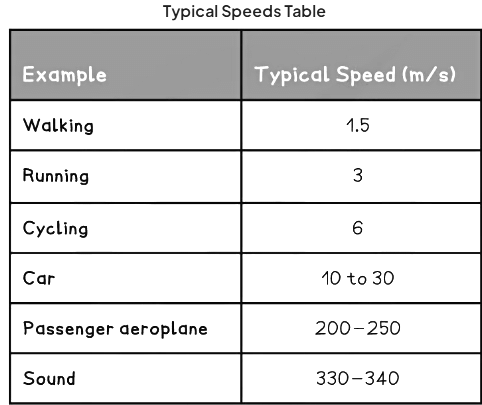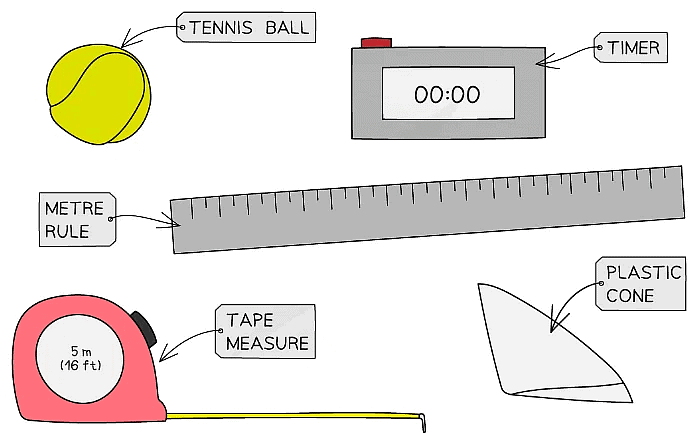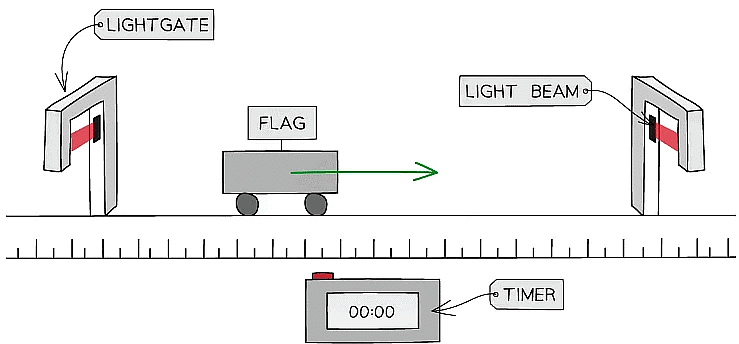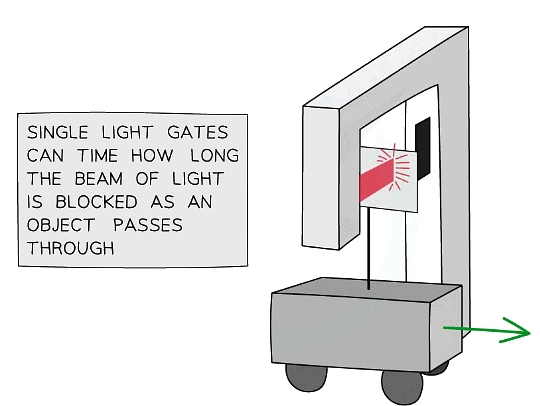Measuring Speed | Physics for Grade 10 PDF Download
| Table of contents |

|
| Typical Speeds |

|
| The Speed of Sound |

|
| Measuring Speed |

|
| Choosing Equipment |

|
| Using Lights Gates to Measure Time |

|
| Single Light Gates to Measure Speed |

|
Typical Speeds
- The table below gives some typical speeds (in m/s) for various everyday scenarios

- Note that typical speeds of a person walking, running or cycling depends on a variety of factors, such as:
- Age
- Terrain
- Fitness
- Distance
- Similarly, typical speeds of transportation systems like cars or planes will depend on their:
- Shape
- Design
- Cost
- Purpose
Example: A student claims that people typically walk at 6 m/s.
(a) State whether or not you agree with this claim and explain your reasoning.
(b) Suggest a factor that can affect the typical speeds of a person walking.
Part (a)
(i) The student’s claim is incorrect because 6 m/s is too fast
(ii) The typical speed that people walk at is about 1.5 m/sPart (b)
(i) Some factors that can affect the typical speeds of a person walking are:
(ii) The terrain might be wet, rocky or steep
(iii) The age of the person
(iv) The fitness of the person
(v) The length of the walk or journey
Exam Tip: You may be asked to recall typical values of speed for a person walking, running or cycling, or comment on typical values of speed for different types of transportation system - so learn the values in this table and have an idea about how they compare to each other.
The Speed of Sound
- Moving objects aren’t the only things that have varying speeds
- The speed of sound and the speed of the wind also vary
- A typical value for the speed of sound in air is 330 m/s
- Interestingly, the speed of sound in seawater is much faster, typically around 1500 m/s
Measuring Speed
- Speed is the distance travelled by an object every second
- The simplest way to measure the speed of an object, is to time how long it takes to travel a known distance and use the equation:

Choosing Equipment
- To ensure a result for speed is as accurate as possible, choose the appropriate equipment to measure the distance and time
 Some simple equipment that can be used to measure distance and time
Some simple equipment that can be used to measure distance and time - To compare the average falling speed of a tennis ball to a plastic cone, for example, you could use:
- A metre rule to measure the distance they fall from
- A timer to measure how long they take to reach the ground
- It would not be practical to use a metre rule to measure the length of an athletics track though
- In this instance, a more appropriate piece of equipment would be a (long!) tape measure, or even better, a trundle wheel
 A trundle wheel is ideal for measuring long distances
A trundle wheel is ideal for measuring long distances
Using Lights Gates to Measure Time
- Light gates are pieces of digital equipment that allow times to be measured more accurately
 Light gates can be used to accurately time the motion of objects in a laboratory
Light gates can be used to accurately time the motion of objects in a laboratory - A light gate can be used to start a timer when an object passes through it
- A flag on top of the moving object blocks a beam of light as it passes through the light gate, triggering the timer to start
- A second light gate (at some fixed distance away) can be used to stop the timer as the object passes through it
Single Light Gates to Measure Speed
- A single light gate can also be used to measure the speed of an object as it passes through
 Example of using a single light gate to measure speed
Example of using a single light gate to measure speed - The timer measures how long the light gate is blocked for
- The distance travelled is given by the length of the flag passing through the light gate
- The two measurements for distance travelled and time taken can then be used in the equation for speed
Exam Tip: Whenever you’re asked to describe an experiment if you need to use an equation to calculate something, write this down first. The quantities in the equation give you some hints about the variables you might need to measure.
|
122 videos|150 docs|40 tests
|














